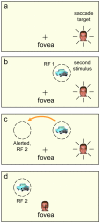Visual stability based on remapping of attention pointers
- PMID: 20189870
- PMCID: PMC2847621
- DOI: 10.1016/j.tics.2010.01.007
Visual stability based on remapping of attention pointers
Abstract
When we move our eyes, we easily keep track of where relevant things are in the world. Recent proposals link this stability to the shifting of receptive fields of neurons in eye movement and attention control areas. Reports of 'spatiotopic' visual aftereffects have also been claimed to support this shifting connectivity even at an early level, but these results have been challenged. Here, the process of updating visual location is described as predictive shifts of location 'pointers' to attended targets, analogous to predictive activation seen cross-modally. We argue that these location pointers, the core operators of spatial attention, are linked to identity information and that such a link is necessary to establish a workable visual architecture and to explain frequently reported positive spatiotopic biases.
Figures



Comment in
-
Shifting attention to neurons.Trends Cogn Sci. 2010 Sep;14(9):389; author reply 390-1. doi: 10.1016/j.tics.2010.06.003. Epub 2010 Jun 28. Trends Cogn Sci. 2010. PMID: 20591722 No abstract available.
-
The missing link for attention pointers: comment on Cavanagh et al.Trends Cogn Sci. 2010 Nov;14(11):473; author reply 474-5. doi: 10.1016/j.tics.2010.08.007. Epub 2010 Sep 28. Trends Cogn Sci. 2010. PMID: 20851665 No abstract available.
References
-
- Breitmeyer BG, et al. The existence and role of retinotopic and spatiotopic forms of visual persistence. Acta Psychol (Amst) 1982;52:175–196. - PubMed
-
- Duhamel JR, et al. Spatial invariance of visual receptive fields in parietal cortex neurons. Nature. 1997;389:845–848. - PubMed
-
- Galletti C, et al. Parietal neurons encoding spatial locations in craniotopic coordinates. Exp Brain Res. 1993;96:221–229. - PubMed
-
- Melcher D. Spatiotopic transfer of visual-form adaptation across saccadic eye movements. Curr Biol. 2005;15:1745–1748. - PubMed
-
- Melcher D, Morrone MC. Spatiotopic temporal integration of visual motion across saccadic eye movements. Nat Neurosci. 2003;6:877–881. - PubMed
Publication types
MeSH terms
Grants and funding
LinkOut - more resources
Full Text Sources

